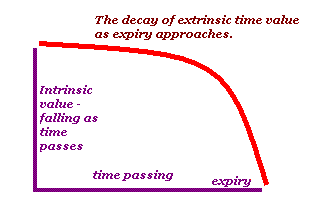Start trading today with our #1 recommended broker, CLICK HERE
Equity Options: Now that we understand a little about options and the rights and obligations that they confer, depending on whether we are a writer or a holder, we now need to take a closer look at the most popular option for online trading – the equity option.
Online Option Trading: Equity Options
Now, as we have already discovered, options have an underlying asset. In this case, and for one of my favourite strategies (covered call writing) we use an equity option, with an underlying asset being the stock or share. The largest market by far is that in the US, followed by the Far East and UK markets. In the US there are literally thousands of equity options to choose from, traded over several different exchanges of which the CBOE is the largest.
Now, lets start with the simple bits first – there are two principle types of options. The first is called American style, and the second is European style. With American style options, the contract can be exercised at any time up until the expiry date, whilst a European contract can only be exercised on the expiry date itself. Fortunately for us all equity options are American style, which means you don’t have to check with your online broker before trading, but remember as we found out on the previous page, the holder of your contract can ask for the underlying asset at any time during the specified life of the option. Having explained that, let’s look at the component elements of the equity option which are as follows and to save you looking back at the previous page, I have copied the definitions for the call and put so you have them here:
| Call Option : A contract that for a specific time gives the right to the holder to buy the specified underlying asset at a specific price at or before a specified time. |
| Put Option : A contract that for a specific time gives the right to the holder to sell the specified underlying asset at a specific price, at or before a specified time. |
Online Option Trading: Equity Option & Expiry Date
OK, the first element was ‘for a specific time’. Now an option is what we call a ‘wasting asset’ – in other words it has a set time limit for the contract, and once that period of time has elapsed, the option has wasted away if no action is taken by the holder, and its value goes to zero! Whilst you may find this strange that the markets trade in things which are going to zero value, you do also do this is real life – when you buy a car, does it increase in value ( only if it is a classic) – NO – it will eventually decline to a worthless piece of scrap much like many other essential commodities we buy.
The concept of time with regard to option trading is a crucial concept as most traders do not realise the power that time has in the value of the premium. Now each option therefore has a specific time during which the holder can take some action or do nothing and the option then expires worthless. Remember the option holder always keeps the premium, whatever happens. Now for each stock or share, you will find many different time periods which give rise to a confusing array of data, which is actually quite simple and which we will look at in a moment.
The most common time period for an option is four weeks, and on any given day, you will find a whole series of options available stretching out for months ahead. So lets assume we are on the 1st August, we will find options for August, September, October, and November. Probably after this they will move to three month periods. As a general rule, the most widely traded options ( generally the blue chip stocks ) will have the following three to four months, and then move to quarterly periods. So what does an August option contract actually mean ? It means that on a set date in August, this option will expire. The dates of expiry are published well in advance, and to keep things as standard as possible, they all expire on the Saturday, following the third Friday in the month! You might ask why it is on a Saturday since no trading occurs over the weekend – the answer is simply that it gives the options brokers the morning to reconcile all the open online positions. Trading on the last Friday is generally heavier than on other days, as traders close positions and holders exercise their contracts.
For most standard equity options, the number of months available will generally be up to 12 months from the current month, so if we are in August 2007, there will be a series of options going out to August 2008. However, there is another type of option called a LEAP which stands for Long Term Equity Anticipation Securities – a bit of a mouthful. These options extend for up to 3 years and are traded in the same way as regular options.
Online Option Trading: Equity Option & Strike Price
The strike price is the ‘specific price’ that we discussed in the definition of calls and puts. This is the price which is written into the option contract and which stays fixed throughout the life of the option. It is like the price of the car that we agreed with the seller in the premium example. Now for each stock or share that we look at there will be a whole series of strike prices for us to choose from, some of which will be above the current market price of the equity, and others which will be below. So for example, lets take McDonald’s – in the current market the stock is trading at $54.37 on the New York Stock Exchange. The equity option for McDonald’s would have a series of strike prices, which would probably move up in $2.50 increments. So for example we may find strike prices of $45, $47.50, $50, $52.50, $55, $57.50 and $60. Each equity option will have different price increments depending on the value of the underlying stock. For a lower value stock trading at say $15, the strike prices could be in $1 or $2.50, so we might have something like $12, $13, $14,,$15,$16,$17 and so on.
Online Option Trading: Equity Options & Contract Size
Now we have mentioned the word contract many times, and you may be wondering how many stocks or shares we are buying – does it differ for each contract, do we decide? N0 – it is much easier than that!. The contract size for each equity option is set by the exchanges and differs from country to country. In the UK options market, one equity option contract represents 1000 shares in the underlying asset, whilst in the US one option contract represents 100 stocks. It is important to realise therefore that when you sell or write an option, if the premium being quoted is $1.00, then you will receive 100 x $1.00 = $100 which will be paid to you by the buyer(now the holder ). In the UK if the premium being quoted was £1.00, then you would receive £1,000 as the underlying contract size is 1000 in the UK. Equally as an option buyer you will have to pay 100 (US) or 1000(UK) times the option price quoted on the online screen. This represents one contract. Naturally if you buy 5 option contracts it’s 500 (US) or 5000 (UK) x the option price.
Online Option Trading: Equity Options – Each One Is Unique
OK, now we have looked at all the elements which make up an option and as we shall see in a minute each one is unique and clearly defined by its constituent parts as follows :
- Firstly we have the underlying asset which defines the option ‘series’ – let’s say it’s McDonald’s
- Secondly we have an expiration month – let’s say October 2007
- Thirdly we have a strike price – let’s say $55.00
- Lastly we have a type – Call or Put – let’s say a call in this case.
So in this case we have chosen an option on McDonald’s stock, which will expire on the Saturday after the third Friday and in October 2007, with a strike price of $55 and it is a CALL option. That’s it – this is a unique option which is defined by the four elements above – there is no ambiguity.
Now options are also defined in another, slightly more complicated way by a series of symbols. By quoting this symbol you are again defining the option as unique. So what are these symbols? – they are as follows and comprise three distinct elements as follows :
- The first element is the underlying asset ticker symbol for the stock or share – in this case it is MCD which is the ticker for McDonalds.
- The second element is the expiration month codes. These change as the months move on, but at the moment they are as follows :
| Month | Calls | Puts |
| January | A | M |
| February | B | N |
| March | C | O |
| April | D | P |
| May | E | Q |
| June | F | R |
| July | G | S |
| August | H | T |
| September | I | U |
| October | J | V |
| November | K | W |
| December | L | X |
- The third element is the strike price codes. I do not propose to list them all as there are thousands, but here are just a few which we will see when we look at an option chain.
| Strike Price in US Dollars | Strike Price Code |
| 50.00 | J |
| 55.00 | K |
| 57.50 | Y |
| 60.00 | L |
With the above elements options are again defined by the underlying asset ticker, the month, the type of option and the strike price. So if we saw the following symbol for an option for example : MCDKY – everyone in the market would know that this was a McDonalds, Call option, expiry in November, and with a strike price of 57.50 USD – a unique definition. It is actually possible to trade using these symbol definitions, but most people do not as it is easier to click a button – but useful information to have as they are always defined this way in the option chains, which is what we will look at now!! All the expiry dates, contract periods and a whole host of useful information on options, can be found at the CBOE site.
| McDonalds – MCD : Expiration Month : October 2007 (Nov 07) (Dec 07) (Jan 08) (Mar 08) (Jan 09) (Jan 10) |
|||||||||||||||
| Sym. | Last | Chg. | Bid | Ask | Vol. | O.I. | Strike | Sym. | Last | Chg. | Bid | Ask | Vol. | O.I. | |
| OCT 07 Calls | 21 days to expiry | MCD @ 54.56 | OCT 07 Puts | ||||||||||||
| MCDJI | 9.90 | 0.00 | 9.50 | 9.80 | 0.00 | 732 | 45.00 | MCDVI | 0.05 | 0.00 | 0.00 | 0.05 | 0.00 | 15117 | |
| MCDJW | 7.80 | 0.00 | 7.10 | 7.30 | 0.00 | 2853 | 47.50 | MCDVW | 0.08 | 0.00 | 0.00 | 0.05 | 0.00 | 6606 | |
| MCDJJ | 4.60 | 0.00 | 4.70 | 4.90 | 0.00 | 2241 | 50.00 | MCDVJ | 0.15 | 0.00 | 0.10 | 0.10 | 0.00 | 7425 | |
| MCDJX | 2.59 | 0.00 | 2.55 | 2.65 | 0.00 | 4842 | 52.50 | MCDVX | 0.48 | 0.00 | 0.40 | 0.25 | 0.00 | 3376 | |
| MCDJK | 1.00 | 0.00 | 0.95 | 1.05 | 0.00 | 5017 | 55.00 | MCDVK | 1.33 | 0.00 | 1.30 | 3.10 | 0.00 | 2769 | |
| MCDJY | 0.25 | 0.00 | 0.20 | 0.30 | 0.00 | 3736 | 57.50 | MCDVY | 3.50 | 0.00 | 3.00 | 8.20 | 0.00 | 1517 | |
| MCDJL | 0.05 | 0.00 | 0.05 | 0.10 | 0.00 | 2438 | 60.00 | MCDVL | 5.80 | 5.40 | 0.00 | 59 | |||
The above table is called an option chain, and lays out all the information in a table that we have discussed above. The option chain is for McDonalds, the underlying asset with the ticker MCD. As you will see on the left we have calls, and on the right puts and these are for the OCT 07 contract period, so will expire on the Saturday after the third Friday in October. As you will see there are 21 days left to expiry. On the left we have the symbol notation that we looked at above which describes in symbol notation every single option traded. As you can see the symbols for calls and puts are different as you would expect. In the centre of the table in red we have the strike prices and as you can see, we have a variety to chose from starting at $45.00 and moving in $2.50 increments up to $60.00. The ‘last’ column is the last price quoted, and the change is showing zero as the markets were closed when I took these prices. Had the markets been open, then this column will show the change in the option premium ( up or down ). The bid and ask are as you would expect and the same as for any other traded instrument. This is the premium of ONE option contract, and remember the underlying asset is 100 MCD stocks. So if we wrote the Oct. O7 MCD option contract with a strike of $55, we would receive a premium of 0.95 x 100 = $95.
The vol. column again is showing zeros as the markets are closed, but in live trading this column would show how many contract had been traded on the day. Finally the OI column shows how many ‘Open Interest’ contracts there are for each option, in other words how many contracts are live and being traded. As you can see from a glance at the numbers there are significantly more puts being traded than calls below the current market price of the stock. This would tend to suggest that traders are bearish on the stock and investors are buying options in case of a fall in prices.
OK, I hope that the above has de-mystified some of the jargon and mystery surrounding options terminology – now we are going to have a look at all the elements which combine to determine the premiums quoted and what analysis you need to undertake in order to understand the option value, and to identify online trading opportunities for particular strategies.
Start trading today with our #1 recommended broker, CLICK HERE















